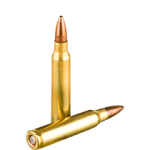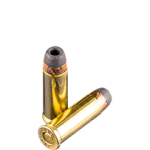Description
Designed by Remington benchrest shooter Mike Walker in 1950, the .222 Remington was initially sold as the cartridge for one of their bolt action rifles – the Model 726. Remington still produces rifles chambered for .222 today, as do Ruger and some European companies. It was the first varmint cartridge designed specifically for use in bolt action rifles, which is one of the reasons it set the bar for later varmint cartridges to come. The .222 was the second cartridge of this caliber to have a rimless case, the first being the .22 Newton.
Most of the .22 centerfires that preceded this round were modified cartridges from larger rounds, but not so of the 222 Remington. This was a totally brand new round. Originally, the cartridge came with 48-grain bullet standard. However, this proved ineffective against the varmints for which the round was designed. Soon after its introduction, the 48-grain bullets were replaced with 50 grain. Because it has a velocity of 3,200 feet per second, it boasts a greater range than the .22 Hornet as well as greater accuracy than the .220 Swift.
222 Ammo and Benchrest Shooting
Designer Mike Walker was one of the founders of International Benchrest Shooters. He first fired the cartridge in a competition at Johnstown, New York, in 1950. A Remington employee, the rifle he used eventually transformed into the 40X target rifle sold by Remington – one of the dominant rifles in benchrest competition until the mid-1970s.
If football is a game of inches, competitive benchrest shooting is a game of nanometers. High-precision rifles are mounted onto a bench, then fired at a paper target. Like most benchrest shooters, Mike Walker was a tinkerer who was always looking for ways to improve his round. The 222, which dominated the sport for decades, is arguably his crowning achievement.
Benchrest shooting is a sport dominated by gunsmiths. Much of the difference in competition is made by the skill involved in tinkering with custom firearms to get increasing amounts of accuracy. Unlike other forms of competitive shooting, however, handloading ammunition is strictly prohibited in benchrest shooting. Stock ammunition must be used, but the weapons can be modified in any way. The sport evolved out of varmint hunting, which requires incredible amounts of accuracy.
Despite the fact that it is no longer de rigeur in the world of competitive benchrest, it has a solitary achievement that can never be duplicated: It was the first round to ever be fired in a perfect grouping. On September 23, 1973, Mac McMillan shot a 0.0000″ grouping, the first perfect one-hold grouping in competition ever recorded. The final verified grouping accuracy after being sent around to seven judges was finally measured at 0.009″. This stood as a record for 40 years until Mike Stinnett beat it by 0.002″ with 30 PPC rounds.
The Decline of the 222 Ammo
The .222 Remington was introduced shortly after World War II, and was the first new cartridge of the era presented by a large manufacturer. A unique characteristic about this round is that the case is original, as opposed to modifying an already existing case to become the new caliber. Since the .222 was introduced, however, it has become the inspiration for many other successful cartridges – including the .17 Remington, .221 Fireball and the .223 Remington. The last of these has largely eclipsed the 222 for dropping varmints, as rounds produced by the American military tend to perform a lot better than their civilian counterparts.
A leader in benchrest competitive shooting for nearly a quarter century, the accuracy of the .222 exceeded every other cartridge of the era, and established new standards for competitive shooting at long distances. It was only finally dethroned by the 6mm PPC and the .22 PPC. The .222 Remington is no longer used for competitive shooting, but it remains a well respected cartridge among varmint shooters.
Can You Hunt With 222 Ammo?
While mostly known as a competitive benchrest round and a varmint round, it has a certain audience among those who hunt medium-sized game. Medium-game hunters like the round because of its light weight and almost imperceptible recoil, as well as its high levels of accuracy – all things that make it perfect for competitive benchrest shooting. It’s often touted as a great round for women, young people or as a training round. However, not everyone is convinced. It has been said that the 222 simply does not have the stopping power and is not an ideal round for medium-sized game. Barring a head or neck shot, it might not be capable of actually felling an animal.
There’s an amusing anecdote about this worth sharing: A man became so in love with the 222 that he started using it on everything. He was knocking down deer, sheep and antelope with it. Then he tried it on a black bear who promptly chased him up a tree, where he sat until his wife came along with a 30-06 to finish the job. After this incident, he only used the round to drop gophers.
The Triple Deuce in the Military
Known as the “triple deuce,” the 222 Remington almost saw action in the military, as it was originally designed for the AR-15 with 20 percent greater powder capacity. It ultimately wasn’t accepted by the military as a standard round, but it has entered the commercial market. While this round is practically obsolete, it retains a core of followers in the handloading community. It also acted as the parent round of the .204 Ruger.
The 5.56x45mm NATO is likewise a stretched out 222 designed for the M16. It was built to satisfy the following parameters:
.22 caliber
Supersonic at 500 yards
A six-pound rifle weight
20-round magazine capacity
Semi- and fully automatic capability
Able to penetrate .135-inch steel plate and a U.S. helmet at 500 yards
Several companies, including Remington and Winchester, quickly set to work trying to come up with the round NATO was looking for. The result was an international movement toward smaller, lighter weight, higher velocity rounds for military service. This allowed for a greater carrying capacity for soldiers in the field.
While the round is all but obsolete in the United States, it still enjoys popularity in Europe. Sako, Tikka and Sauer continue to produce the round regularly. One reason for this is that many nations in Europe ban civilians from owning “military” caliber rounds. The 223 is classed as a military-grade round and the 222 is close enough – but not as far as the law is concerned.
The .222 today is mostly employed to hunt varmints up to 250 yards out, as well as small deer in Europe. Its bullets commonly weigh between 40 and 60 grains in the common configurations of FMJ and SP, and muzzle velocity ranges from just less than 3,000 feet per second to more than 3,500 feet per second.
The best features of this cartridge include groups at less than MOA, gentle recoil, mild muzzle blast and lower operating pressures than similar cartridges – which extends the life of chambers and barrels. Rifles are not currently manufactured in volume for the .222 , but many companies still manufacture .222 ammunition.
Even though the competitive days have ended for the .222 Remington, it remains an excellent choice for hunting varmint and small game.





